Consultation 9 & 10 November 2007
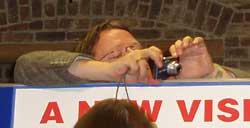
The Event
This was the jumbo meeting of all the stakeholders (in St. Catherine's church [CORE] on the 9th and in the Digital Hub Hopstore on the 10th of November 2007). You can view the flyer for this meeting here.
To recap, the organisation of the consultations has been entrusted by the City Council to an English firm John Thompson Partners. The team is led by Clare San Martin.
Form
These meetings took the form, almost exclusively, of workshops. The workshop agendas were flexible and were tweaked to take account of progress during the sessions. There were a number of walkabouts and the groups reported back regularly to the plenary session.
The expectation created at the neighbourhood consultations was that this jumbo session would represent a coming together of all the stakeholders (mainly residents, developers and City Council) and that the (conflicting) requirements of the various stakeholders would be in the melting pot leading to a more comprehensive output than at the purely residents' meetings.
 While there were some people there from the Dublin City Council Administration, including the project manager, the general impression of the meetings was of a rerun of the neighbourhood consultations with the principal inputs coming from the residents and the John Thompson team, with limited input from the City Council, and not a developer in sight (well, not to my untrained eye, anyway).
While there were some people there from the Dublin City Council Administration, including the project manager, the general impression of the meetings was of a rerun of the neighbourhood consultations with the principal inputs coming from the residents and the John Thompson team, with limited input from the City Council, and not a developer in sight (well, not to my untrained eye, anyway).The groups seemed to me to work well in the circumstances. The residents reiterated much of what was said at the previous meetings but there was an emphasis on being more focused and specific and a more weight given to some of the likely constraints facing many of the proposals/desiderata. The team seemed very receptive to the ideas being put forward and helped to focus them. It remains to be seen how they come through in the final presentation of stakeholders interests and the strategic plan.
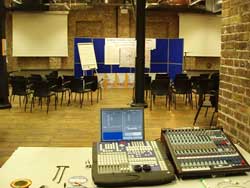 Again there were many photos taken which will certainly convey an impression of intensive consultation. Postering and lighting on the set ensured that a professional visual record will be available. The value of this on the positive/cynical scale will depend on the degree to which residents' interests are accommodated in the final plan.
Again there were many photos taken which will certainly convey an impression of intensive consultation. Postering and lighting on the set ensured that a professional visual record will be available. The value of this on the positive/cynical scale will depend on the degree to which residents' interests are accommodated in the final plan. There was a good sound system with a radio mike which ensured that even the most hesitant presentations came across.
I thought the attendance was quite low (about 50?) but the team seemed to think that it was par for the course and probably quite good in the circumstances.
There was a problem with advance publicity, yet again. A lot of the flyers which were promised did not arrive in residents' letterboxes. I had left my email at the last meeting and got good notice of this one. A small niggle, though. The initial email message consisted of the relatively large flyer and the later email (day before the meeting), while summarising the details in the body of the message, also included the hefty flyer as an attachment. I don't know to what extent this impinged on residents as I don't know the extent of final (including forwarding) email circulation or how many recipients were on broadband or dial-up.
Content
- Parameters
One of the problems involved in the whole consultation process was the absence of a summary of what were the limits, if any, on a process of change or regeneration, imposed by irreversible developments already in place or existing land ownership/planning permissions. On the one hand you could argue, as some did, that the absence of such constraints led to more imaginative solutions being proposed. But, at the end of the day, the constraints were likely to kick in anyway and a lot of time may have been spent refining proposals that stood no chance of getting off the starting blocks.
- Safety
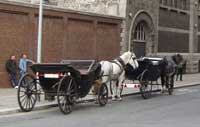 Most of the residents, and more particularly the women, were very concerned about personal safety in the area. Prevalence of drugs, narrow high streets and poor lighting at night were seen as negative factors. Prior to the meeting I had been wandering in the vicinity of one of the flat complexes taking photos and was approached by one of the local mothers who told me to put away the camera as "people steal cameras around here". It was not lost on me that I would probably need to have been bonked on the head first. On another occasion, during one of the walkabouts, one of the jarveys outside the Guinness Hopstore was very perturbed to see a party he took to be tourists heading towards the flats. He tried to dissuade us from going in that direction saying "it was wanky down there". This bore out the contention of one of the people at the previous consultation that those visiting the Guinness Hopstore are dissuaded from straying and as a result do not contribute to the local economy.
Most of the residents, and more particularly the women, were very concerned about personal safety in the area. Prevalence of drugs, narrow high streets and poor lighting at night were seen as negative factors. Prior to the meeting I had been wandering in the vicinity of one of the flat complexes taking photos and was approached by one of the local mothers who told me to put away the camera as "people steal cameras around here". It was not lost on me that I would probably need to have been bonked on the head first. On another occasion, during one of the walkabouts, one of the jarveys outside the Guinness Hopstore was very perturbed to see a party he took to be tourists heading towards the flats. He tried to dissuade us from going in that direction saying "it was wanky down there". This bore out the contention of one of the people at the previous consultation that those visiting the Guinness Hopstore are dissuaded from straying and as a result do not contribute to the local economy.
- Area specific development
There was a feeling that development should exploit the current and historic strengths of the area. On this basis the broader area was looked at as a number of separate but related constituent parts. The Coombe was suited to markets of various sorts and perhaps some very light industry. The harbour/basin area had potential for development as an open area, with some water features restored, and caf�s and artisan workshops as well as in-character residential units. The vast complex of Guinness warehouses, storehouses, vathouses and god-knows-what houses could be imaginatively developed on the inside as was being done in the digital hub development. The schools area at the harbour could be developed into an area of academic excellence and linked into to the local social fabric. And so on.
- Luas
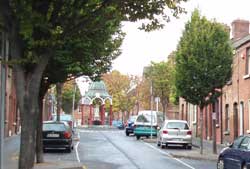 The Luas is due to cut through the area to connect up the existing red and green lines. The options currently being considered would involve the connection coming in along James's Street and Thomas Street or branching off from behind James's Hospital, through Marrowbone Lane and the Coombe and onto Stephen's Green. Residents favour the Thomas Street option where there is an existing wide thouroughfare and the alternative route would split up the Coombe community and be very noisy at the sharp gradient.
The Luas is due to cut through the area to connect up the existing red and green lines. The options currently being considered would involve the connection coming in along James's Street and Thomas Street or branching off from behind James's Hospital, through Marrowbone Lane and the Coombe and onto Stephen's Green. Residents favour the Thomas Street option where there is an existing wide thouroughfare and the alternative route would split up the Coombe community and be very noisy at the sharp gradient.
- Permanent Residents
There was a strong feeling that a significant proportion of any accommodation in the area should be taken up by permanent residents, including families. Transients do not contribute to the local economy and can undermine the population thresholds needed to sustain local services (for example, schools).
- Interconnection
North/South and East/West roadways should be developed in the interest of integrating the community as much as possibe and providing ready access to facilities. The current layout and lack of development is a disincentive to tourists to go walkabout. Lack of signage likewise.
Outcome
These meetings did refine people's thinking and there was a fair amount of interplay between those present. It will be interesting to see what the team will present on next Wednesday evening (14 Nov. 7pm, St. Catherine's Church,CORE, Thomas St.).
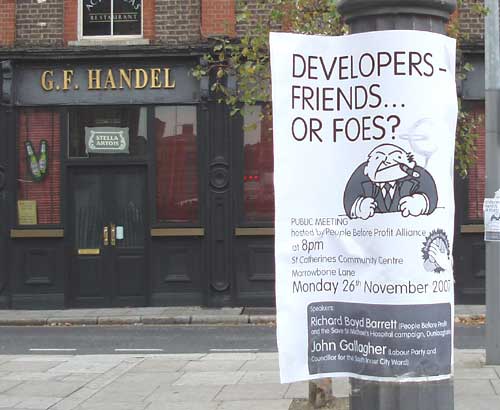
Bounded on the north by James's/Thomas St., south by Cork St.,
west by the hospital and east by Francis St.
